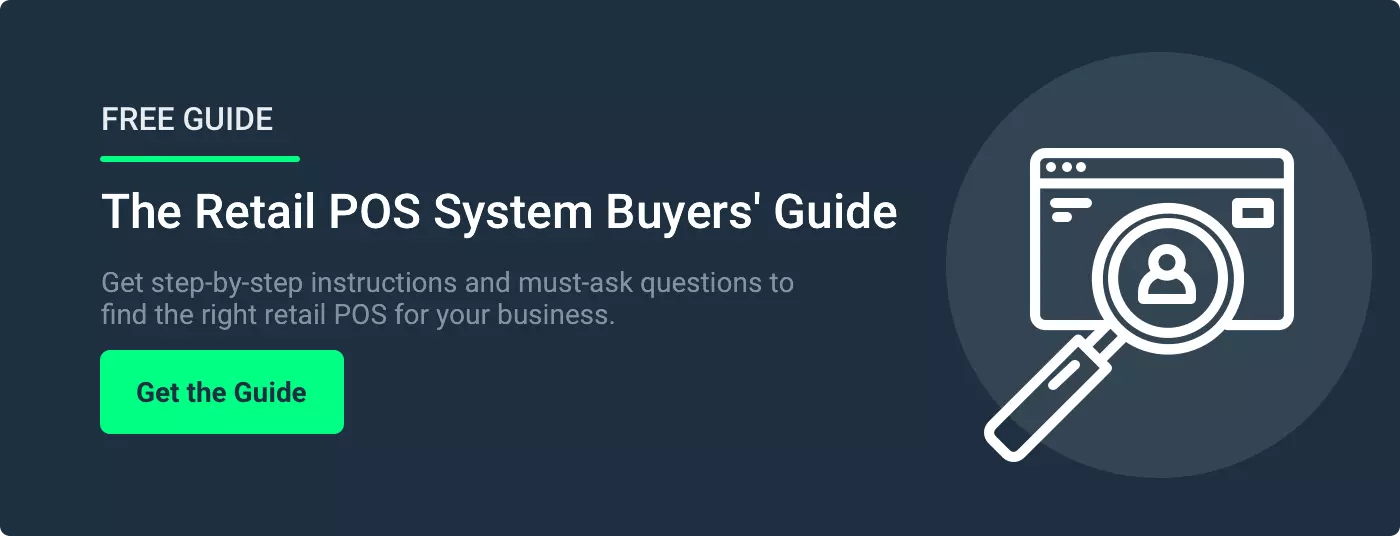Merchandising, employee training, and vendor management. These are just a few of the small things that add up to big wins — or losses — depending on how you manage them.
Another one of these “little things” as a retailer is understanding your point of sale (POS) debit and point of sale charges. Not every transaction shows up the same on your financial statements, and confusion is the last thing you want when dealing with your cash flow.
We will run you through the basics of POS debit and point of sale charges.
By the end of this post, you’ll be a pro at deciphering your financial statements for the different types of POS debit charges. You’ll also understand why a unique merchant descriptor is crucial for limiting customer confusion.
POS Debit Transactions: Let’s Start at the Beginning
First, we need to answer one of the most common questions about point of sale transactions: What is the difference between credit and debit transactions?
Every transaction completed on your point of sale system is a POS transaction, but whether that transaction is credit or debit can impact your bottom line. Processing rates for debit transactions are typically lower than those for credit transactions. If you encourage your customers to pay with debit when possible, you can save on processing fees in the long run.
Related Read: 5 Best POS Systems With Retail Credit Card Processing
But here's where it gets tricky — not all debit transactions are created equal. Different types of debit transactions often show up differently on your financial statements from the bank, which can lead to some confusion when you're trying to reconcile your accounts and payment processing at the end of the month.
With a basic understanding of the different types of debit transitions and how they’re labeled on bank statements, you can better keep your books in order and make informed decisions for your business.
Let's examine the different debit transaction descriptions you might encounter.
6 Types of POS Debit Transactions Descriptions
While each POS debit transaction involves a customer using a debit card to make a purchase, these transactions can come in several forms. Let’s examine the six main types of POS debit transaction descriptions you may encounter on a bank statement.
- PIN debit purchase
The most common type of debit transaction, a PIN debit purchase, occurs when a customer pays for an item by swiping, tapping, or inserting their debit card into the chip reader and entering their personal identification number (PIN). This type of transaction is quick, easy, and secure, making it a popular choice for in-store purchases.
- Signature debit purchase
A signature debit purchase still involves using a debit card to make a payment. However, instead of entering a PIN, the customer signs for the purchase, similar to a credit card transaction. This type of transaction is less common than PIN debit purchases but is still widely accepted by many retailers.
- Debit card purchase
A catch-all term for any transaction made using a debit card, "debit card purchase" is a broad description that includes PIN and signature debit purchases.
- Online debit purchase
You may see online debit purchases on your statements if you have an online store besides your brick-and-mortar operation. An online debit purchase is a transaction made over the Internet with a debit card. Unlike in-store purchases, online debit transactions don't require PIN entry or signatures. Instead, the purchase is processed using a card number, expiration date, and card verification value (CVV) number.
- Phone debit purchase
Like online debit purchases, phone debit purchases involve paying over the phone using your debit card. Like online transactions, phone debit purchases are processed using card numbers, expiration dates, and CVV numbers without requiring a PIN or signature.
- Recurring debit purchase
If your store offers a subscription box or monthly service, you may receive recurring debit payments. This type of transaction automatically charges a customer’s debit card using their card number, expiration date, and CVV number.
Related Read: The Best POS Systems for Retail: 10 Options for 2024
Understanding the different types of POS debit transaction descriptions will better equip you to manage your finances and keep track of payments and bank statements for your store.
Though these are the most common types of POS debit transactions, you may also encounter some additional debit card payment types in your store, which we’ll explore in more detail below.
POS Debit Transactions Made with Digital Wallets
One increasingly popular POS debit transaction type is a digital wallet payment. Once considered a fringe payment type not accepted by many retailers, digital wallets have grown in popularity in recent years.
Suppose you aren’t accepting digital payments yet. In that case, you may want to consider implementing a point of sale system that accepts mobile and contactless payments — 65% of American adults have used a digital wallet to purchase something in the last month.
Related Read: 6 Major Advantages of Contactless Payment
Google Pay, Apple Pay, and Samsung Pay are three of the most popular digital wallets. These platforms allow users to store payment information within an application and make payments directly from their smartphones.
But what does this mean for POS debit transactions?
Interestingly, purchases made using a digital wallet are processed in much the same way as traditional debit transactions made with your POS system. When a customer uses their digital wallet to make a payment, the transaction is handled just like any other debit purchase, with the funds being withdrawn directly from the customer's linked bank account.
As digital wallets become more popular, it’s wise to be prepared to accept and report on these payments. Implementing a modern point of sale system with flexible payment processing and advanced reporting features is critical if you want to keep up with digital wallet transactions.
Card-Not-Present Transactions
Another indication you may see is a card-not-present (CNP) transaction. What is a CNP transaction? Simply, any transaction where the card is not physically present. Types of transactions that fall under this category include:
- Online purchases
- Phone purchases
- Digital wallet purchases
One of the main differences between CNP transactions and traditional in-person debit purchases is the cost. CNP transactions tend to have higher processing fees associated with them. This increased processing fee is because there's a greater risk of fraud when the card is not physically present during the transaction.
In fact, according to industry experts, around 70% of all card fraud occurs in card-not-present scenarios. Business owners need to be aware of this higher risk of fraud and take steps to mitigate it.
Of course, you should still accept CNP transactions. In today's market, processing online and mobile payments is essential for staying competitive and meeting your customers' needs. The key is to balance accepting these payment types and limiting your exposure to fraud.
Related Read: What Is POS Security? 5 Ways To Protect Customer Data
One way to do this is by implementing security measures like the Address Verification System (AVS) and CVV checks. AVS compares the billing address provided by the customer with the address on file at the card issuer. CVV checks require the customer to enter the three — or four-digit security code found on their card. Both measures can help verify that the person making the purchase is the legitimate cardholder.
Another important step is to closely monitor your bank statements for chargebacks and disputed payments. If you do see a fraudulent transaction, respond quickly and provide the necessary documentation to help resolve the issue.
Finally, ensure your point of sale system has strong data security measures and complies with all PCI regulations and requirements. Keep your systems up to date with the latest security patches, and follow all best practices for securing sensitive data.
Merchant Descriptors: A Critical Component of POS Debit Transactions
Last, let’s examine an often-overlooked POS debit transaction puzzle piece: the merchant descriptor.
This descriptor is the information that appears on your customer's bank statements or online transaction history when they make a purchase from your store. It's designed to help them quickly and easily identify where their money was spent without having to rack their brains or dig through receipts.
Setting up your merchant descriptor accurately and properly is critical. Why? Because when the merchant descriptor is not easily recognizable as coming from your store, it can lead to challenges, including:
- Confusion
- Customer frustration
- Chargebacks
Related Read: EMV Chargeback Fraud: How To Detect And Avoid It
When customers can’t easily identify your place of business on their bank statements, they may panic and attempt to recoup the losses from a legitimate charge, thinking their information was stolen.
How can you avoid these pitfalls and create a merchant descriptor that works for your business? Here are a few tips to keep in mind:
- Use a recognizable name: Make sure your descriptor includes your business name or a variation that customers will easily recognize. Avoid generic terms or abbreviations that could apply to multiple companies.
- Include your location: Adding your town or city name can help customers connect the transaction to a specific visit to your store or a purchase made in your area.
- Provide your website URL: If you have an online presence, including your website URL can help customers quickly confirm that the transaction is legitimate and learn more about your business.
- Add a customer service number: Including a phone number for customer service can give customers peace of mind and a way to easily contact you if they have questions or concerns about a transaction.
By following these tips and creating a clear, informative merchant descriptor, you can help your customers feel confident and secure in their purchases while reducing the risk of confusion and chargebacks.
POS Debit Transactions Are a Breeze With the Right POS System
Keeping the types of POS debit transactions discussed in this post in mind can help set you up for success in managing point of sale charges at your store. However, we know these processes can feel overwhelming without the right tools.
A modern point of sale system is the most important tool for managing your transactions effectively. The right POS solution will cover all the nitty-gritty details covered in this post, making debit payments a breeze for your store.
With POS Nation, your debit transactions are organized in a user-friendly transaction log, complete with clear descriptions that make reconciling your accounts a snap. Plus, each transaction includes your unique merchant descriptor, set up with your card processor, so you always know where your money is coming from.
And when it comes to security, POS Nation has your back. The system doesn't store sensitive card or transaction information but instead encrypts it and passes it securely to the payment processor. This means you can rest easy knowing you're protected against card fraud without any extra hassle.
Ready to take your retail game to the next level? Check out POS Nation's comprehensive Retail POS Guide to ensure you know exactly what features and capabilities you need in a POS system.






 by Cort Ouzts
by Cort Ouzts


 by Graham Hoffman
by Graham Hoffman
